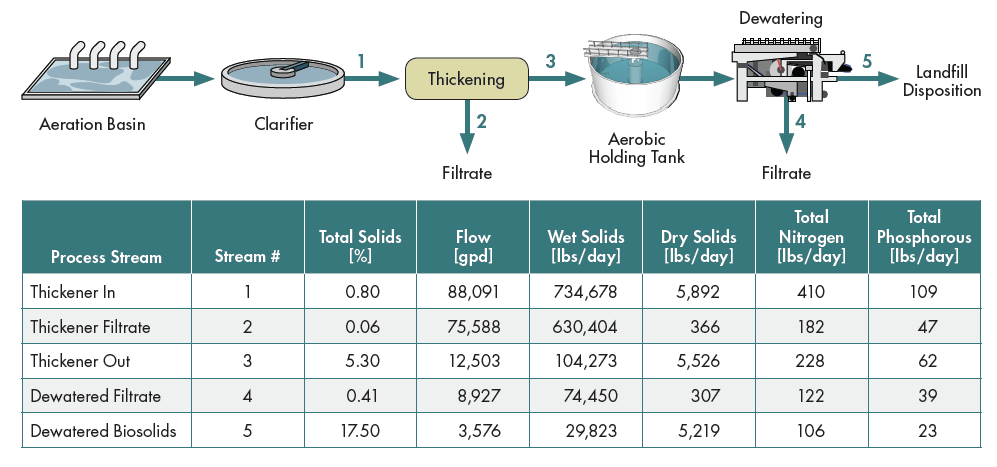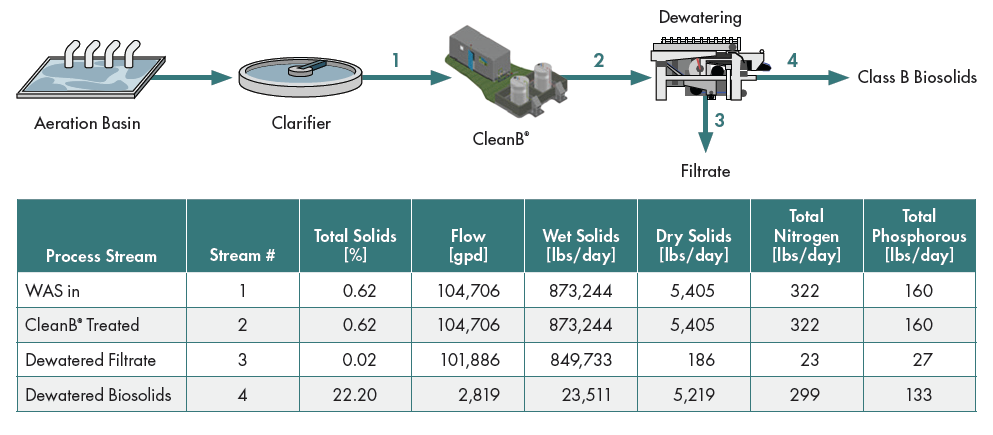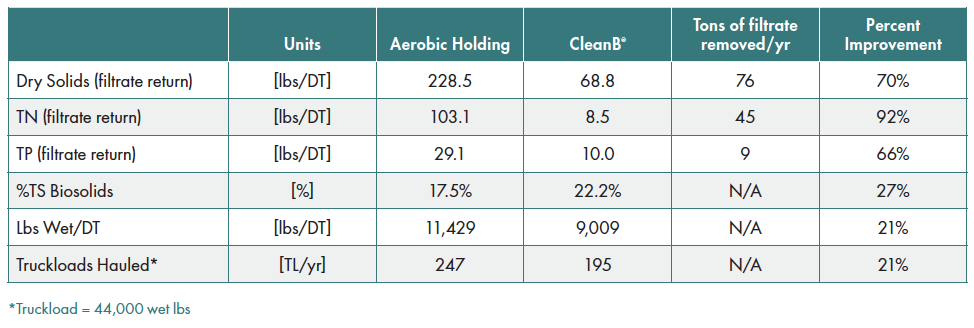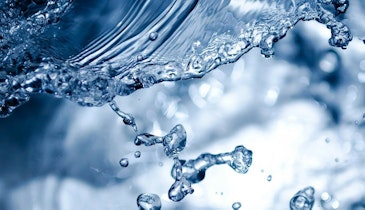Interested in Dewatering/Biosolids?
Get Dewatering/Biosolids articles, news and videos right in your inbox! Sign up now.
Dewatering/Biosolids + Get AlertsIn September of 2014, a CleanB system was installed at the wastewater treatment facility in Fort Pierce, Florida. Before the CleanB installation, the plant wasted to a DAF unit for thickening and held sludge in an aerobic holding tank prior to contract dewatering and landfill disposition. After installation of the CleanB system, the plant started wasting directly from the clarifier to the CleanB unit and centrifuge dewatering.
Differences in nutrients leaving the clarifier were noted and were attributed to the timing of the samples. The capture rates of solids and nutrients after installation of the CleanB show a substantial improvement when compared to the previous practice. Percent capture of nitrogen went from 25.9 percent with DAF thickening and aerobic holding to 92.9 percent with CleanB treatment. Percent capture of phosphorous went from 21.1 percent to 83.1 percent with CleanB treatment.
CleanB installation
The key conclusions from this work effort are:
- Solids return via filtrate was reduced by 70 percent (76 tons per year)
- Total nitrogen return via filtrate was reduced by 92 percent (45 tons per year)
- Total phosphorous return via filtrate was reduced by 66 percent (9 tons per year)
- Percent total solids of dewatered biosolids improved by 21 percent (52 fewer truckloads per year)
- Total polymer consumption was reduced by 34 percent (reduction of 26.8 pounds/DT)
- Total nitrogen leaving with the biosolids was increased by 182 percent (35 tons per year)
- Total phosphorous leaving with the biosolids was increased by 476 percent (20 tons per year)
- A $57,000 per annum expense from the aerobic holding tank blowers were taken offline
- Energy/greenhouse gas emission savings equates to 50.8 cars per year or 86.4 tons of waste sent to the landfill
In addition to the advantages of higher capture rates and reductions in greenhouse gas emissions, it is estimated that Fort Pierce WWTF will now realize a $242,000 savings per year in operating cost using the CleanB versus their original aerobic holding processing. Below is a summary of the net impact to operations utilizing the CleanB as compared to aerobic holding at Fort Pierce:
Aerobic holding mass balance
The following is a mass balance for the aerobic holding process while treating 2.6 DT/day. Using the results provided by the lab analyses, a complete mass complete balance was calculated around the aerobic holding process at Fort Pierce WWTF. The balance was done by simultaneously solving equations to calculate the filtrate and dewatered biosolids flow by using the Thickener Inflow %TS, Thickener Outflow %TS, Thickener Filtrate %TS, Dewatered Filtrate %TS, and Dewatered Biosolids %TS. The mass balance represents a 952 DT/year facility operating seven days a week. Since surface aerators were used at Fort Pierce with a short SRT, their aerobic holding process did not achieve a volatile solids reduction.
CleanB mass balance
The following is a mass balance for the CleanB process while treating 2.6 DT/day. Using the results provided by the lab analyses, a complete mass complete balance was calculated around the whole CleanB unit. The mass balance represents the CleanB installed directly after the clarifier and treating 952 DT/year operating seven days a week.
Mass balance comparative
The table below summarizes the results of pounds of nutrients returned to the plant via centrate and the solids concentration of dewatered biosolids requiring disposal:
It should be noted that the filtrate returns were summed for aerobic holding (thickening and dewatering) and then compared to the filtrate return for the CleanB process (dewatering). The total nitrogen return on a dry ton basis with their aerobic holding was 103.1 pounds, whereas the CleanB showed 8.5 pounds return per dry ton, or a 92 percent reduction. The high capture rate of nitrogen in the biosolids reduces 45 tons of nitrogen being returned to the head works per year for this size facility (952 DT/year). Total phosphorous returned via the centrate is smaller, 66 percent reduction or 9 tons per year, but still is significant. The benefits of reducing the amount of nutrients returning to the plant are two fold: Fewer returned nutrients means less reprocessing within the liquid treatment train; and secondly more captured nutrients in the biosolids means a more valuable soil amendment.
The CleanB produced a much drier cake; there was an observed 27 percent increase in cake solids (17.5 percent to 22.2 percent cake solids) for the dewatered biosolids. The change in cake solids equates to a 21 percent reduction in wet weight. When considering this facility produces 952 DT/year, the facility can now expect to decrease the number of truckloads hauled per year by 52 (assuming 44,000 pounds per truckload), or a 21 percent decrease in hauling. In addition to producing a drier cake, there was an observed 40 percent reduction in polymer consumption.
Polymer comparison
In addition to an increase of nutrient capture and greater dewatered solids concentrations, the CleanB has significantly reduced polymer consumption of the plant. Below are the consumption rates of each process.
Aerobic holding:
- Thickening polymer consumption: 19.3 pounds/DT
- Dewatering polymer consumption: 59.5 pounds/DT
- Total polymer consumption: 78.8 pounds/DT
CleanB:
- Total polymer consumption: 52.0 pounds/DT
Dewatering and hauling costs
In normal operation the Fort Pierce WWTF dilutes its stream from the digester from 5.3 percent TS to 2.5 percent TS in order to dewater. They were paying 5.39 cents per gallon dewatered. This cost included dewatering, hauling and disposition. Assuming an annual output of 952 dry tons per year, their dewatering, hauling, and disposition costs amounted to $492,209 per year.









